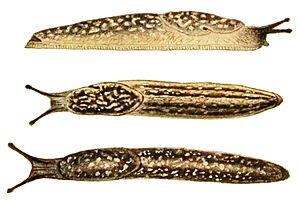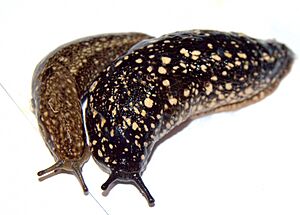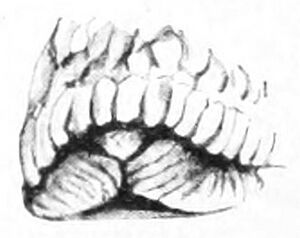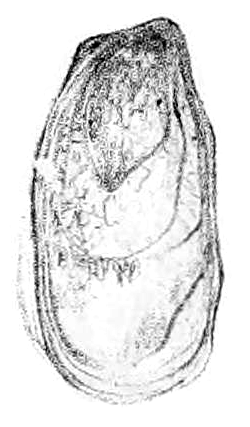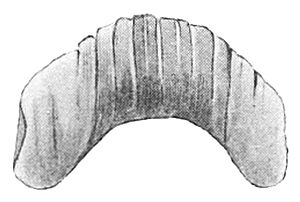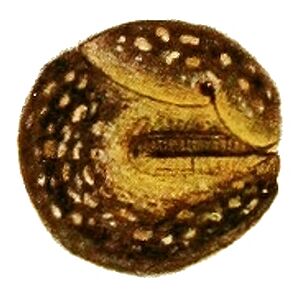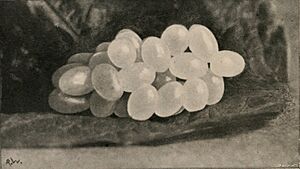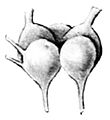Kerry slug facts for kids
Quick facts for kids Kerry slug |
|
|---|---|
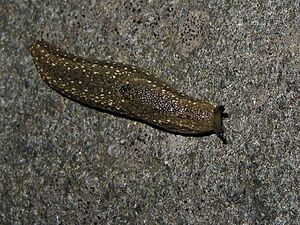 |
|
| Photo of dorsal view | |
 |
|
| Drawing of right side view | |
| Conservation status | |
| Scientific classification | |
| Genus: |
Geomalacus
|
| Species: |
maculosus
|
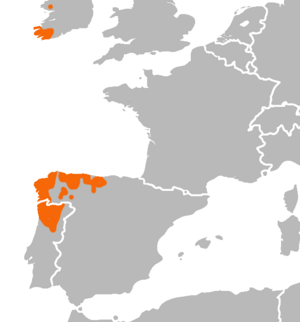 |
|
| Distribution map for the species. | |
| Synonyms | |
|
|
The Kerry slug (Geomalacus maculosus) is a special type of land slug. It's a medium-sized, air-breathing mollusc (like snails and clams). This slug belongs to the family called Arionidae, known as roundback slugs.
Adult Kerry slugs are usually about 7 to 8 centimeters (about 3 inches) long. They are dark grey or brown with cool yellowish spots. This slug was first described in 1843. This was later than many other large slugs in Ireland and Great Britain. This shows how rare and secretive they are!
You can find the Kerry slug in south-western Ireland, including County Kerry. But it's actually more common in north-western Spain and central-to-northern Portugal. Because it's only found in Ireland and this part of Iberia, it has what's called a Lusitanian distribution. This means it lives in places that were once connected by land or climate.
The Kerry slug needs places with lots of moisture and warm summer weather. It also likes acidic soils that don't have calcium carbonate. These slugs are mostly active at night (nocturnal) or during dawn and dusk (crepuscular). But in Ireland, they can be active during cloudy days too. They love to eat lichens, liverworts, mosses, and fungi. These foods grow on rocks and tree trunks.
The Kerry slug is protected by laws in the countries where it lives. People are also trying to breed them in special places to help them survive.
Contents
Understanding the Kerry Slug's Name
The Kerry slug is a gastropod. This is a group of molluscs that includes all snails and slugs. This includes those living on land, in freshwater, and in the ocean. The Kerry slug breathes air using a lung, just like us!
It belongs to a group called Stylommatophora. These animals have two pairs of tentacles that can pull back into their bodies. The top pair even has eyes on the tips! Its family is Arionidae, which are the round-backed slugs. Unlike some other slugs, the Kerry slug doesn't have a ridge (called a keel) on its back.
The slug's scientific name is Geomalacus maculosus. Maculosus means "spotted" in Latin, which makes sense because of its spots! The common name "Kerry slug" comes from County Kerry in Ireland. This is where the first slugs used for its scientific description were found.
In 1842, a naturalist named William Andrews found these slugs near Caragh Lake in County Kerry. He sent them to an Irish biologist, George James Allman. The next year, Allman showed them off and officially described the new species. So, the full scientific name is Geomalacus maculosus Allman, 1843.
What Does the Kerry Slug Look Like?
Adult Kerry slugs are usually 7 to 8 centimeters long. It can be tricky to measure them because they have a funny way of reacting when scared! They can also stretch themselves up to 12 centimeters (about 5 inches) when they squeeze into cracks.
The Kerry slug's body is shiny and covered with about 25 rows of small, polygon-shaped bumps. These slugs can be either brown or black. In Ireland, black slugs are found in open areas, and brown slugs live in woodlands. This helps them blend in with their surroundings, like camouflage! Scientists think that being exposed to light makes them darker as they grow.
They can also have two faint bands on each side of their body. These bands usually run the whole length of the body. Over these bands are many oval yellow spots.
Behind the slug's head is a shield-shaped area called the mantle. This part is about a third of the body's length when the slug is moving. But when it's still, it can be half the body's length. The mantle has a texture like leather and is covered with pale spots, just like the rest of the body.
The edge of the slug's foot is very pale and has faint lines. The bottom of the foot is pale grey-yellow and has three faint bands. At the very tip of the tail, there's a small triangular pit called the caudal mucous pit. This pit collects extra mucus, which often looks like a clear, yellowish ball.
The Kerry slug's upper tentacles are dark grey or black. They are short and thick with oval ends, and their eyes are right on the tips. The lower tentacles are pale grey and see-through. The slug's body mucus is usually pale yellow and can be thick or thin. The mucus it uses to move is sticky and usually clear, but sometimes it's yellow from mixing with other body fluids.
Inside the Kerry Slug
Hidden Shell
Most land slugs have a small, leftover shell inside their bodies. For the Kerry slug, this internal shell is a solid, chalky plate. It's oval-shaped and looks a bit like the shells found in Limax slugs. It's usually curved on top and hollow underneath, with faint growth lines.
Body Systems
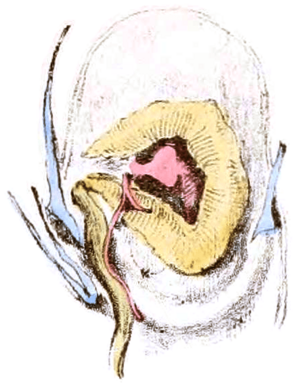
The Kerry slug's heart is surrounded by its triangular kidney. The heart's main chamber (ventricle) is very close to its breathing and waste openings. This is different from its relatives in the Arion genus.
The slug also has special glands in its head and foot. These are similar to those in Arion slugs.
Muscles for Movement
The Kerry slug has muscles that help it pull its head and tentacles back into its body. The muscles for the eye tentacles are dark. These muscles attach to the back edge of the mantle. There's also a muscle that helps with feeding, attached near the mouth.
How the Kerry Slug Eats
The Radula
Inside the slug's mouth is a special feeding tool called a radula. It's like a tiny, strong ribbon covered with many rows of small teeth. This tool is unique to molluscs!
The Kerry slug's radula is about 8 millimeters long and 2 millimeters wide. It has 240 rows of tiny teeth. Each row has one small middle tooth and 10 teeth on each side. The teeth have different shapes and sizes, helping the slug scrape off its food.

The Jaw
The Kerry slug's jaw is about 1 millimeter wide. It's curved and very wide with rounded ends. The jaw is solid, dark brown, and has about 10 flat ridges in the middle. These ridges can make the edges of the jaw look toothed.
Like all slugs in the Arionidae family, the Kerry slug's digestive system forms two loops.
Where Do Kerry Slugs Live?
The Kerry slug has a scattered distribution. It's found only in Ireland (mostly the southwest), north-western Spain, and central-to-northern Portugal. This type of scattered pattern is called a "Lusitanian distribution".
Some people think the Kerry slug might have been brought to Ireland from Iberia by early humans. This is because the slugs in Ireland have less genetic variety than those in Spain and Portugal.
In Ireland
In Ireland, the Kerry slug lives in areas with sandstone rocks in West Cork and County Kerry. This area is about 5,800 square kilometers (2,200 square miles). In 2010, a new group of slugs was found further north in County Galway.
Protected Areas in Ireland
Many places where the Kerry slug lives in Ireland are protected. These are called Special Areas of Conservation (SACs). Seven SACs have been set up to protect this slug, including Glengarriff Harbour and Woodland and Killarney National Park.
In Spain and Portugal
Even though it's called the Kerry slug, Ireland is at the edge of its range. The main home for these slugs, with the most genetic variety, is in the north-western part of the Iberian peninsula. The Kerry slug has been known in northern Spain since 1868 and in northern Portugal since 1873.
In Portugal
The southernmost place where you can find this slug is the Serra da Estrela mountains in Portugal. It's also found in several provinces like Minho and in the Peneda-Gerês National Park.
In Spain
In Spain, the slug lives along the coast in Galicia and stretches through the Cantabrian Mountains to the Basque Country. This includes areas in Galicia, Asturias, Cantabria, Castile and León, and the Basque Country.
Protected Areas in Spain
Many places in Spain are also protected for the Kerry slug. These are part of the Natura 2000 network. For example, in Asturias, there's the Muniellos site. In Cantabria, you can find them near the Camesa river. Galicia has many sites, including the Eo river area.
How Kerry Slugs Behave
The Kerry slug is mostly active at night. During the day, it usually hides in rock cracks or under loose tree bark. In Spain and Portugal, young slugs become active at dusk, and adults are active at night, especially when it's rainy or very humid. Because Ireland is cooler and wetter, the Kerry slug sometimes comes out during the day if the weather is humid and cloudy.
This slug has a very unusual way of defending itself. Most slugs pull in their heads and shrink their bodies, staying stuck to the ground. But the Kerry slug pulls in its head, lets go of whatever it's on, and rolls itself into a tight ball! This behavior is unique among slugs in its family and in Ireland.
Kerry Slug's Environment and Food
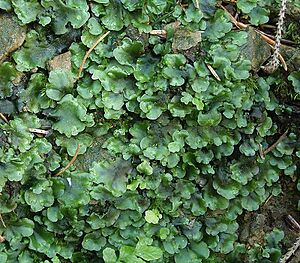

Where They Live
People once thought the Kerry slug only lived in wild places. But in Spain and Portugal, it can be found on tree trunks in oak and chestnut forests. It's even easier to spot them in places changed by humans, like rocky walls in orchards, old ruins, or near houses and churches. In Ireland, they also live in conifer tree farms and areas where trees have been cut down. The Kerry slug is not a farm pest, unlike some other slugs.
In Ireland, the Kerry slug lives in oak woodlands, open moorlands, blanket bogs, and lake shores. They especially like places with boulders covered in lichens and mosses. While they were often found in sandstone areas, a new group was found in Galway on granite. In Spain and Portugal, they usually live in granite mountains and on other types of rocks. The best sign that they might be there is lots of rain and warm summer temperatures.
What They Eat
The Kerry slug eats lichens, liverworts, mosses, fungi (like Fistulina hepatica), and bacteria. These foods grow on rocks and tree trunks. When kept in captivity, they have eaten porridge, bread, dandelion leaves, carrots, cabbage, cucumber, and lettuce. They can even eat other snails sometimes!
Life Cycle of the Kerry Slug
In the wild, Kerry slugs lay their eggs between July and October. In captivity, they can lay eggs from February to October. They lay eggs in groups of 18 to 30, held together by a thin layer of mucus. Each egg cluster is about 3.5 by 2 centimeters (about 1.4 by 0.8 inches).
The eggs are very large compared to the slug itself. They are milky-white or shiny when fresh. After a few days, they turn yellowish, then brown or black.
Young slugs usually hatch in six to eight weeks. At this stage, their spots are barely visible. They have distinct black bands that are more noticeable than in adult slugs. Young slugs also have special markings on their mantle that look like a lyre (a small harp). These markings fade as they grow.
Kerry slugs likely spend their first winter as young slugs that are not yet ready to reproduce. They become adults in two years, when they are about 2.6 centimeters (1 inch) long. In the wild, Kerry slugs can live for up to seven years. But in captivity, they usually live for less than three years.
Until 2014, scientists didn't know what animals ate Kerry slugs. Now we know that the larvae (young) of a fly called Tetanocera elata are predators of the Kerry slug.
Slug Parasites
Kerry slugs can also get parasites called nematodes (tiny worms). One type of nematode, Phasmarhabditis californica, has been found to parasitize Kerry slugs in Ireland. However, the slug is immune to another similar nematode, P. hermaphrodita.
Dangers to the Kerry Slug

The biggest danger to the Kerry slug is probably changes to its habitat. This reduces the amount of lichen and moss it has to eat. This can make the slugs disappear from certain areas, which has happened in Spain. Other dangers include:
- More intense land use (like farming)
- Draining wet lands
- Using pesticides
- Too much grazing by sheep
- Removing shrubs
- Tourism and building new developments
- Planting conifer tree farms
- The spread of invasive plants like Rhododendron ponticum
- Breaking up their habitat into smaller pieces.
Other possible dangers are climate change and air pollution. These can harm the lichens that the Kerry slug eats. Climate change might affect the slugs in Spain and Portugal more because those areas are already hotter and drier than Ireland.
Protecting the Kerry Slug
International Efforts
Because the Kerry slug was thought to be rare and found in only a few places, it's protected by the Convention on the Conservation of European Wildlife and Natural Habitats (Bern Convention). This decision was made after studies showed that the slug was declining in Spain and its status in Ireland was uncertain. Since 2006, the Kerry slug has been listed as a "least concern" species on the IUCN Red List. This means it's not currently at high risk of extinction. However, between 1994 and 2006, it was considered "vulnerable".
The Kerry slug is also protected by the European Union's Habitats Directive. This means countries must create Special Areas of Conservation (SACs) to protect its habitats. Seven SACs have been set up for this slug in Ireland, and 49 in Spain. The Habitats Directive also protects the slug itself, even outside these special areas. It makes sure that:
- Countries set up a "strict protection system" for these species.
- It's against the law to purposely catch or kill them.
- It's against the law to purposely disturb them, especially when they are breeding, raising young, hibernating, or migrating.
- It's against the law to purposely destroy or take their eggs from the wild.
- It's against the law to purposely or accidentally damage or destroy their breeding or resting places.
Protection in Ireland
In 1988, only three places where the slug lived in Ireland were protected. Scientists realized this wasn't enough to keep the species safe. So, they pushed for it to be included in the Bern Convention. The Habitats Directive was then made part of Irish law.
The Kerry slug has been protected since 1990 under the Irish Wildlife Act of 1976. It was the only slug protected by this law! This law protects the slug from direct harm, like being collected.
In 2008, the Irish National Parks and Wildlife Service created a plan to help the Kerry slug. However, this plan was later updated in 2010. This happened after a court ruled that Ireland wasn't protecting the slug as strictly as the European Union required.
Watching Over the Slugs
In a report from 2007, Ireland said the slug's conservation status was "favorable." But the European Court of Justice questioned this, saying Ireland wasn't watching the slug properly.
The 2010 plan recognized that more information was needed about slug populations, especially outside the protected areas. It said that proper monitoring, which means regularly checking the slug's numbers and where it lives, hadn't really been done yet. The Kerry Slug Survey of Ireland then worked to find a good way to monitor the species. They published a guide in 2011 about the Kerry slug's population changes.
Breeding in Captivity
Since 1990, the Kerry slug has been successfully bred in captivity. The Wildfowl & Wetlands Trust, a British conservation group, has a breeding program. They keep the slugs in special containers called terraria at their Martin Mere Wetland Centre in England. In the 1990s, some slugs from this program were given to zoos and individuals to start their own breeding groups. However, not many of these groups survived.
Images for kids
-
Anatomy viewed from below with frontal edge of mantle on the top. Heart (red) is surrounded by renal organ (yellow). Retractor muscles (blue) include retractor muscle of left eye tentacle (depicted on the right), retractor muscle of right eye tentacle and retractor muscle of odontophore (both on the left).
-
The cerebral ganglia, a central processing area which is equivalent to the brain within the nervous system of the slug



